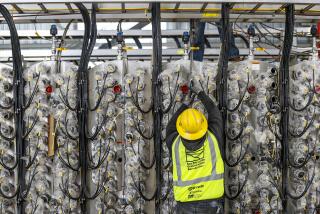L.A. Toasts âClearer, Better-Tastingâ Water
Toasting with glasses containing what Mayor Tom Bradley called the âelixir of the Department of Water and Power,â city officials on Tuesday dedicated a $146-million water filtration plant in Sylmar that is bringing Los Angeles residents clearer and better-tasting water.
The plant uses ozone to purify water, reducing by 50% the chlorine added and thus improving its taste, said Rick J. Caruso, president of the Board of Water and Power Commissioners.
âAlthough water quality has always been good in the city . . . now itâs going to be even better,â Caruso said.
The state-of-the-art plant, built to meet stringent federal standards, is the largest water-treatment facility using the ozone process, DWP officials said. The technique has been used in European water plants since the turn of the century.
The filtration system makes the water clearer by reducing the fine, dustlike particles in it, Caruso said. The trihalomethanes, a family of compounds suspected of causing cancer in humans, have been halved to well below the federal safety limit, Caruso said.
Flow Began on Nov. 28
Los Angeles residents began drinking tap water from the Sylmar plant, which will produce 75% of the cityâs supply, on Nov. 28. Residents of the San Fernando Valley and West Los Angeles will drink its water year-round, whereas those living in Hollywood and downtown will tap into the supply during the winter, when more water flows through the cityâs principal aqueduct, according to Duane Georgeson, the DWPâs assistant general manager.
The plant is processing water that has traveled 338 miles through the Los Angeles Aqueduct system from the Owens Valley. The water reaches the plant after cascading over and through Terminal Hill, visible to northbound motorists on the Golden State Freeway in Sylmar.
The plant first screens out pebbles, leaves and occasional rattlesnakes, frogs and bluegills. Then the water is disinfected by tiny ozone bubbles created at the plant by splitting and recombining oxygen molecules. Finally, the water is chemically treated, filtered and chlorinated.
On Tuesday, Bradley and DWP officials could hardly contain their glee at the kudos given to the cityâs water in the January, 1987, issue of Consumer Reports. The group rated the cityâs tap water--in taste tests conducted before the new plant was in use--at the top of the list, above that of other cities and popular brands of bottled water.
âFor the price of a glass of Department of Water and Power water, you can get 8,000 glasses for what youâd pay for one glass of the typical bottled water,â Bradley said.
The mayor said he was so impressed with the new taste that he has cut off city employeesâ supply of bottled water. The city had spent âwell overâ $150,000 a year on bottled water, he said.
âI now know that there is no excuse, no health reasons, no problem with turbidity, no problem with taste that should require any city employee to have to pay . . . for that kind drinking water,â Bradley said
The public is invited to an open house at the water plant this spring.
Although some officials on Tuesday tasted the âelixir,â delivered in fancy glasses on a sterling silver tray, other visitors had to walk away thirsty.
Drinking fountains at the plant were not working.
âThey havenât been hooked up yet,â a DWP spokesman explained.
More to Read
Sign up for Essential California
The most important California stories and recommendations in your inbox every morning.
You may occasionally receive promotional content from the Los Angeles Times.










